After thinking for a long time, I decided to share my short-term trading strategies in the cryptocurrency space, starting from 50,000 and reaching 20,300,000 in just three years!
If you are currently at a loss and wish to treat cryptocurrency trading as a second career in the future, please read this carefully; you will definitely gain something. I recommend saving it!
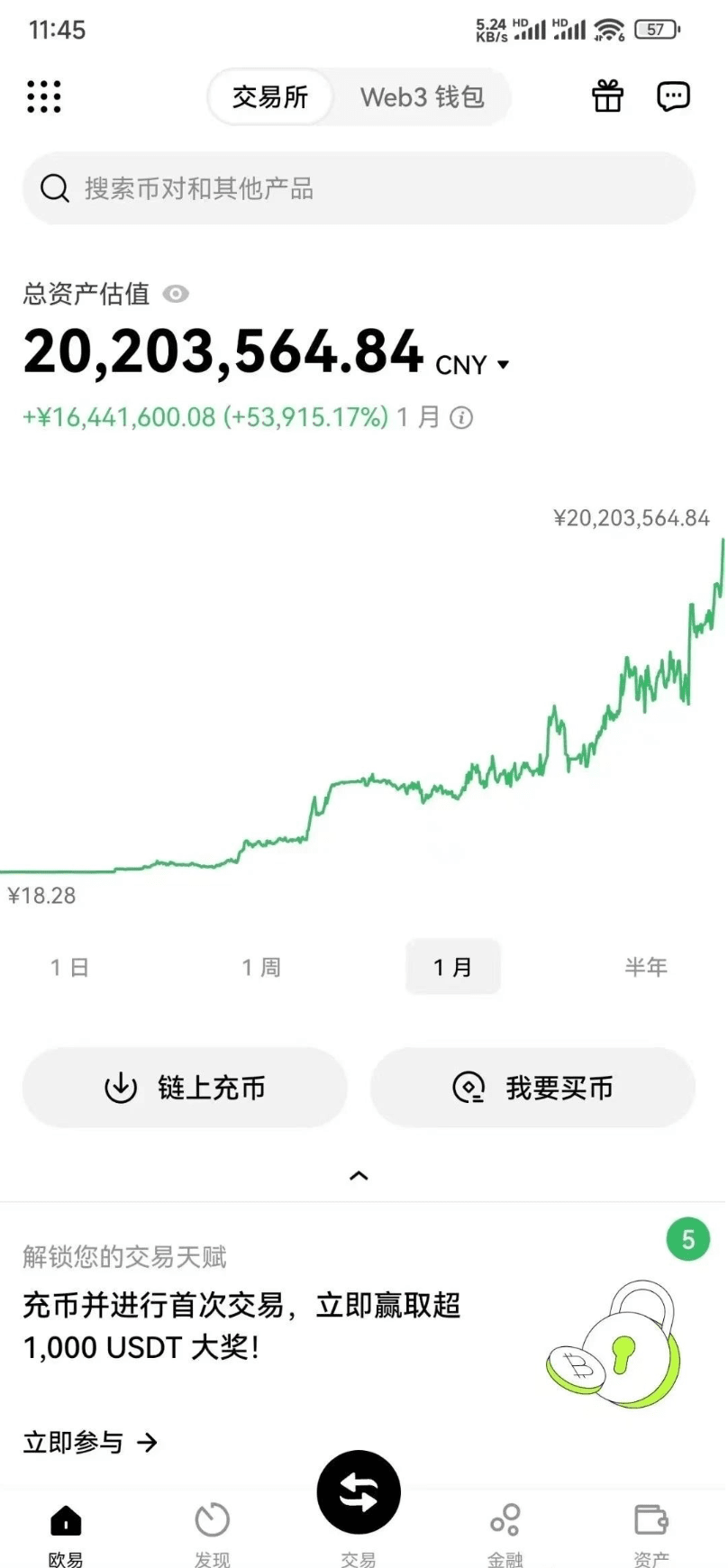
On the road of investment, the market is always the best testing ground. Steady and far-reaching, truly achieving 'investment leads to gains, learning leads to success!' The learning journey in the cryptocurrency world goes from simple to complex and then back to simple. Most people only manage to achieve technical simplicity.
The charm of trading lies in the fact that no single standard fits everyone; bad trades can happen at any time. How one reacts to them determines future success. Trading is an industry that challenges emotions; you can always perfectly explain yesterday. Most people in the cryptocurrency space only know how to go long, so when the market rises, they hesitate to short. Most can make money. However, making money also requires maintaining it to become a winner.
Making profits is difficult, and it is not uncommon to turn gains into losses. It is tragic for those who lack a concept of bull and bear market cycles.
Winners in the cryptocurrency world are not determined by how much profit they make when the market is rising; what truly determines victory is how they fare during market downturns. After spending over ten years in the cryptocurrency space, I have seen too many people fail to make a profit after a bull-bear cycle. During bear markets, everyone gets trapped at the true bottom, a harsh reality of the bullish-bearish cycle.
So how to do well in cryptocurrency trading? Once a person enters the financial market, it is difficult to turn back. If you are currently at a loss but still confused and plan to treat cryptocurrency trading as a second career, you must understand the 'simplest MACD strategy.' Understanding it can save you a lot of detours; these are personal experiences and feelings that I recommend saving and pondering repeatedly!
Welcome everyone to my knowledge-sharing series. The purpose of this series is to guide everyone step by step in learning and judging various situations in the market.
The outline of knowledge sharing can be summarized as starting with the bottom indicator area and then leading everyone to understand the price trend area, including candlestick charts, while interspersing macro concepts such as Dow Theory and Elliott Wave Theory.
Looking at the entire analysis chart, it is mainly divided into price trend area and indicator area. We will proceed step by step, laying a solid foundation first, with the primary content of the first sharing being the MACD indicator.
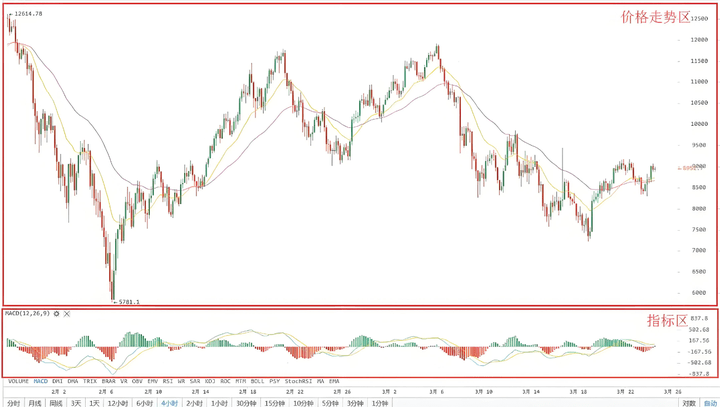
The MACD indicator, also known as the Moving Average Convergence Divergence, is developed from the double exponential moving average. In simple terms, it represents the convergence and divergence between short-term and long-term moving averages, reflecting the current bullish and bearish state and potential price trends through the dispersion and aggregation of short-term and long-term moving averages. It is easier to read, and we often mention MACD in Xiaofang's essays.
The MACD consists of the blue line DIF, yellow line DEA, and histogram. Using the zero axis as the center axis, above zero indicates strength, while below zero indicates weakness. The blue line crossing above the yellow line represents a golden cross, while the blue line crossing below the yellow line represents a death cross.
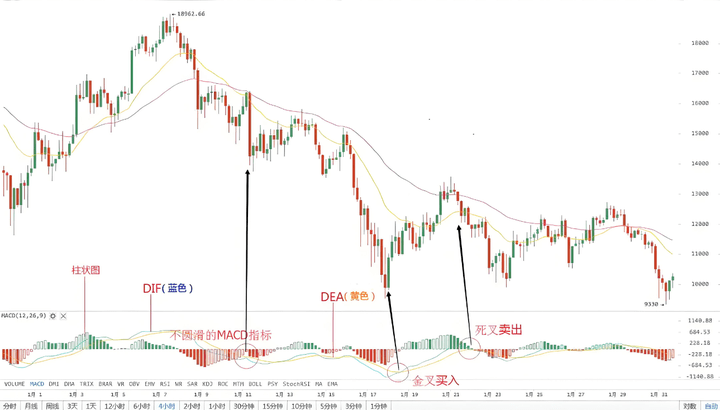
One, in theoretical knowledge, when the MACD turns from negative to positive, it is a buying signal. When the MACD turns from positive to negative, it is a selling signal. When the MACD changes at a large angle, it indicates that the gap between the two moving averages is rapidly widening, representing a major trend change in the market.
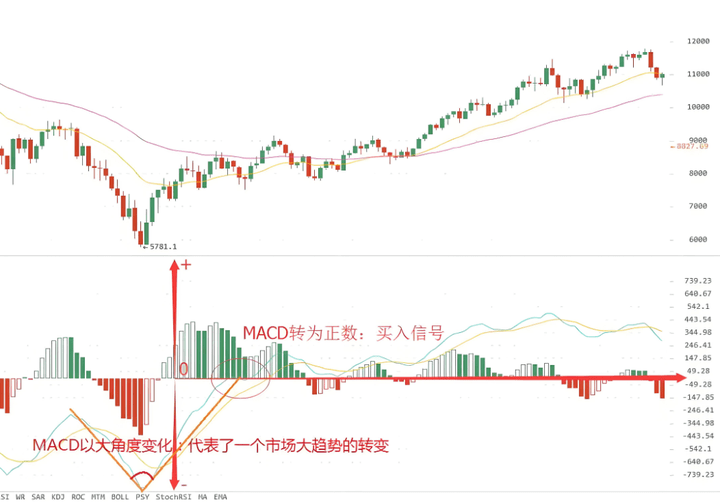
Two, in practical operations, the MACD has two main functions: one is to determine trends, and the other is to judge corrections or reversals through divergence.
1. Buy when a golden cross occurs, sell when a death cross occurs.
In simple terms, it means chasing highs and cutting losses. In a bullish market, buy when there is a golden cross, and sell when there is a death cross in a bearish market. However, in actual operations, it is often necessary to predict golden and death crosses. However, the market makers will not make it easy for you to analyze trends; further operations should be combined with other indicators.
2. Sell when there is a top divergence, buy when there is a bottom divergence.
Generally, the MACD indicator should move in sync with stock prices. However, due to certain factors, sometimes the indicators cannot synchronize with the prices, which is what we often see as divergence. Simply put, divergence is the different movements between price and indicators.
Mainly divided into two types:
(1) Top Divergence: The price reaches a new high while the MACD indicator is declining.
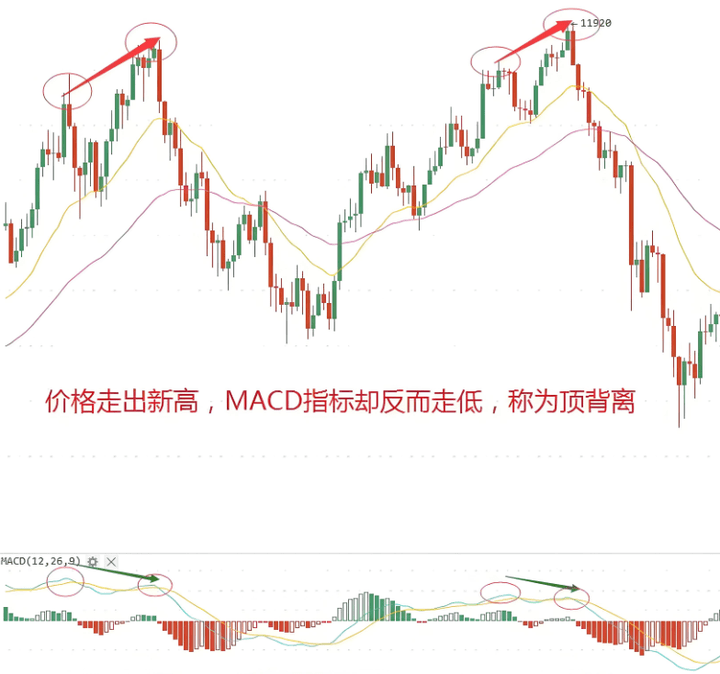
(2) Bottom Divergence: Prices are falling while the MACD indicator is rising.
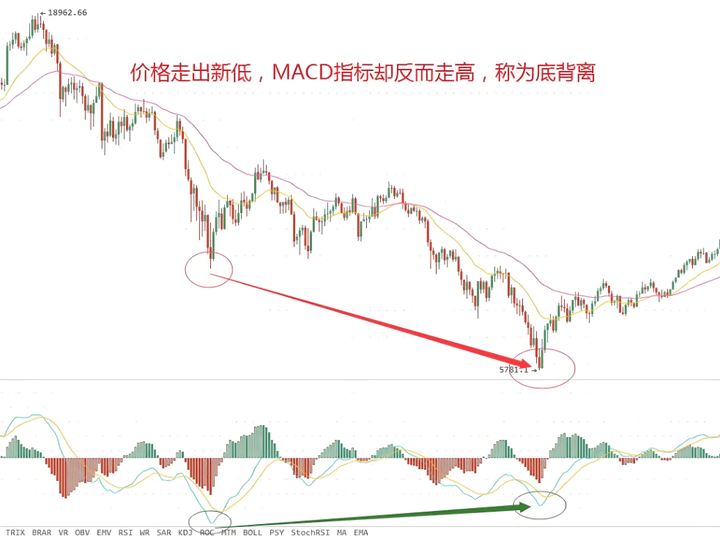
In practice, it can be summarized as selling at the peak and buying at the bottom, selling when there is a divergence at the top, and buying when there is a divergence at the bottom. In a rising market, prices continuously reach new highs, and moving averages are perfectly aligned in a bullish arrangement. However, if you only look at prices and moving averages, it may seem that the upward trend has not yet ended. Nevertheless, after several waves in the market, changes may occur, and the peak divergence of the MACD often alerts everyone that such a market could end at any time.
In summary, the MACD indicator has significant functions, but due to frequent deliberate manipulations of trends, novices are often misled. Once again, we need to combine other indicators for further operations. To go further, we need to take a macro perspective and must not focus solely on a single indicator; this is something everyone must remember.
Let's take another look at the MACD Exponential Moving Average.
In the introduction to K-line, we covered the basics of K-line charts, various patterns, and indicators. Today, I will explain the very important technical indicator 'MACD'. Regardless of whether you understand the specific principles, by observing its historical performance and comparing it with cryptocurrency price trends, we can identify patterns.
The MACD is a very practical indicator that clearly reflects the strength of both bullish and bearish forces, serving as a reference for predicting market trends. It acts as a warning indicator and should not be used as a decisive indicator.
One, Definition
The MACD indicator, in Chinese, is called the Moving Average Indicator. In simple terms, MACD is derived from average lines to calculate the exponential moving average, serving as a very useful indicator in graphical guidance.
1. Enter K-line --- Indicators (as shown) --- Select MACD
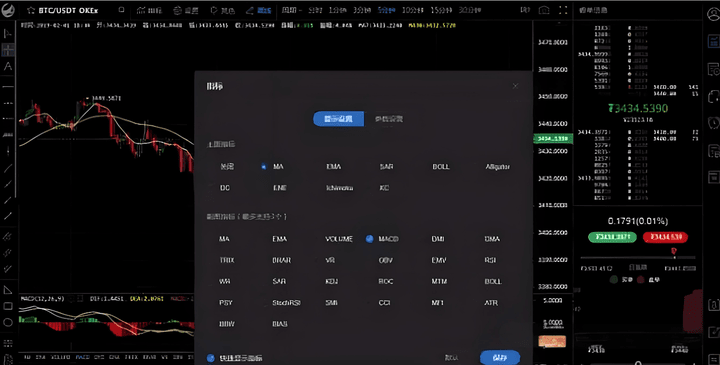
2. Click on parameter design (as shown) --- (default 12, 26, 9)
The cycle can be customized, with the default value being the standard usage. For daily charts, it is 12 days, 26 days; for hourly charts, it is 12 hours, 26 hours, 9 hours.
For daily use, it is 9 days and 12 days, while for hourly use, it is 12 hours, 26 hours, and 9 hours.
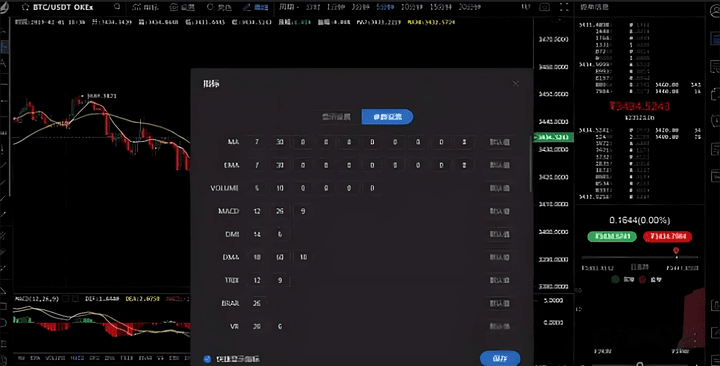
Three, components:
The MACD technical indicators include the DIF line, DEA line, and MACD line.
The MACD technical indicator chart (as shown) consists of the DIF line (white line), DEA line (yellow line), MACD (red and green bars), and the zero axis (the horizontal line in the middle of the green and red bars), making up five parts.
Using the zero axis as the center axis distinguishes the strength of the trend; above 0 is strong, below 0 is weak. I have highlighted the zero axis in the following diagram with a white circle. Bars above the zero axis are green, while those below are red.
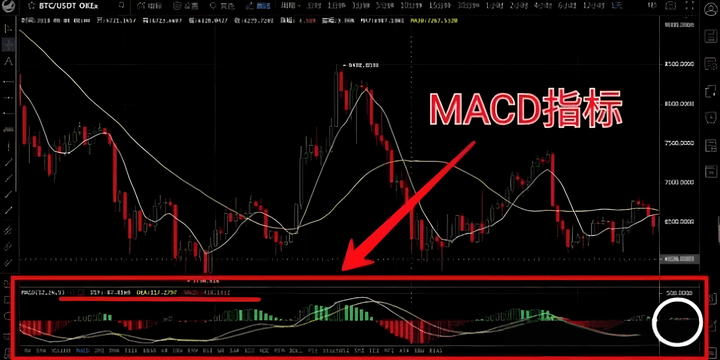
Four, Application:
Observe the DIF line (white line) and DEA line (yellow line); if both lines operate above the zero axis, it indicates a bullish market, representing an upward trend. If they operate below the zero axis, it indicates a bearish market, representing a downward trend.
Five, Golden Cross and Death Cross:
Like other indicators, the MACD indicator also has golden crosses and death crosses:
1. The white line crossing above the yellow line indicates a golden cross (buying signal), representing that the market will rise. If both lines are still operating below the zero axis, it can only be considered a brief rebound and cannot determine a trend reversal. Whether to buy at this time still requires comprehensive judgment with other indicators.
2. The white line crossing below the yellow line indicates a death cross (selling signal), representing that the market will move downwards. If both lines are still operating above the zero axis, it can only be considered a brief pullback and cannot determine a trend reversal. Whether to sell at this time still requires comprehensive judgment with other indicators.
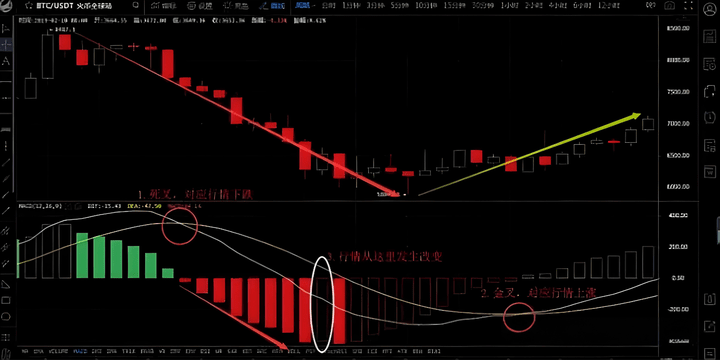
3. When will you notice changes in the market?
It is necessary to use the MACD histogram; longer bars represent greater downward momentum, while shorter bars represent smaller downward momentum. The bars can be solid or hollow; if a red bar is shorter than the previous one, it is hollow. If a green bar is shorter than the previous one, it is solid.
The histogram contracts and expands. Generally, continuous contraction of the histogram indicates that the strength of the trend is gradually weakening. When the color of the histogram changes, it indicates a confirmed trend reversal. However, in some cases where the MACD indicator is used over short time periods, this viewpoint may not hold completely.
When the position at 3 in the chart appears, it indicates that the downward momentum is beginning to weaken, and the market shows some changes. The red bars are continuously shrinking.
Therefore, golden crosses and death crosses should be used in conjunction with red and green bars.
4. When the price is not moving from top to bottom or bottom to top but maintaining a horizontal movement, at this time,
False signals will be generated in the MACD indicator, and the cross between the DIF line and the MACD line will occur very frequently.
At the same time, the expansion and contraction of the histogram will occur frequently, with colors often changing from green to red or from red to green.
The MACD indicator is in a distorted state, and its usability decreases accordingly.
Six, MACD Indicator Divergence:
The trend of the MACD indicator chart is exactly opposite to the K-line chart. Simply put, the K-line chart can rebound upwards, indicating a buying signal.
The price and MACD indicator show inconsistent trends, such as: price rising while the MACD indicator is flat or declining.
As the price trend declines, the indicator moves upwards or remains flat. The MACD indicator divergence has both top and bottom divergences.
1. Top Divergence
When the price continues to rise in the high zone while the indicator continues to fall, the indicator shows a trend opposite to the price movement.
Top divergence phenomena generally indicate that the price is at a high level and about to reverse, suggesting that the price is likely to fall shortly.
This indicates a selling signal.
2. Bottom Divergence
When the price of a coin continues to decline in the low zone while the indicator continues to rise, the indicator shows a trend opposite to the price movement.
The bottom divergence phenomenon generally indicates a possible reversal signal upwards in the short term, suggesting that prices may rise shortly.
Can rebound upwards, indicating a buying signal.
Seven, the MACD is one of the more useful and intuitive indicators among all indicators, better than KDJ and RSI covered in previous courses.
these simple lines are more intuitive.
Emphasizing the following! The MACD also has drawbacks, and many times it has a lagging nature, especially for coins with low circulation.
Indicators with relatively small values may be less effective. Do not blindly trust a single technical indicator; we must base our actual operations on multiple indicators.
Analyze based on actual market conditions and multiple technical indicators to verify market trends more accurately.

Finally, pay attention to the six key insights!
1. Coin Hoarding Method: Suitable for both bull and bear markets. The coin hoarding method is the simplest yet the most challenging strategy. It is simple because it involves buying a particular coin or several coins and holding them for more than half a year or a year without any action. Generally, the minimum return is tenfold. However, beginners often find it hard to resist the temptation of high returns or panic when the coin price plummets, leading them to switch or exit. Many find it hard to stick to not taking action for even a month, let alone a year.
2. Bull Market Dip Buying Method: Suitable only for bull markets. Use a portion of idle funds, preferably no more than one-fifth of your total capital. This method is suitable for coins with a market value between 20 and 100, as it won't lead to prolonged losses. For example, if you buy the first altcoin and it rises 50% or more, you can swap it for the next coin that has plummeted. If your first altcoin is stuck, just wait; the bull market will surely free you.
3. Hourglass Switching Method: Suitable for a bull market. In a bull market, basically any cryptocurrency you buy will rise. The funds act like a giant hourglass, slowly seeping into each cryptocurrency starting from the larger coins. There is a clear pattern in price rises: leading coins rise first, such as BTC, ETH, DASH, ETC, and then mainstream coins begin to rise, such as LTC, XMR, BNB, NEO, DOGE, SHIB, etc. Finally, the coins that haven't risen will experience broad increases, such as RDN, XRP, ZEC, etc., and then a series of smaller coins will take turns to rise.
4. Pyramid Bottom Buying Method: Suitable for predicted major crashes. Bottom buying method: Place orders to buy one-tenth of your capital at 80% of the coin price, one-fifth at 70%, one-third at 60%, and one-fourth at 50%.
5. Violent Coin Hoarding Method: Focus on coins you are familiar with; suitable only for high-quality long-term coins. With a portion of liquid funds, if a coin is currently priced at $8, place an order to buy at $7. When the buy order is successfully executed, place a sell order at $8.8. Profit comes from hoarding coins. Withdraw the liquid funds and wait for the next opportunity. Adjust dynamically based on the current price.
6. Small Coin Violent Play: If you have 10,000 RMB, divide it into ten parts, buying ten different types of small coins, preferably priced under 3 RMB. After buying, do not pay attention to it. If a certain coin triples, take out your original investment of 1,000 RMB and invest in the next small coin. The compound interest returns can be astonishing!
No matter how diligent the fisherman is, he will not go out to sea during a storm but will carefully guard his fishing boat. This season will pass, and sunny days will come! Follow me to learn both fishing and how to fish; the doors of the cryptocurrency world are always open. Going with the trend will lead to a life in harmony with the times. Save this and keep it in mind!